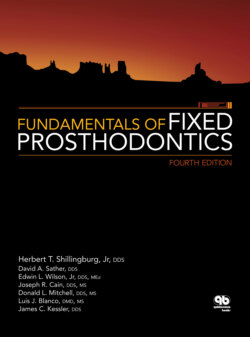Читать книгу Fundamentals of Fixed Prosthodontics - James C. Kessler - Страница 47
На сайте Литреса книга снята с продажи.
Registration of Condylar Movements
ОглавлениеTo faithfully simulate the condylar movement on an articulator, it is necessary to obtain a precise tracing of the paths followed by the condyle. This can be achieved most accurately by means of a pantographic recording, which will capture all of the characteristics of the mandibular border movement from its optimum position to its most forward and most lateral positions.
The pantograph consists of two facebows. One is affixed to the maxilla and the other to the mandible, using clutches that attach to the teeth in the respective arches. Recording styli are attached to the one member, and small tables upon which the tracings are made are attached to the other member of the instrument, opposite the styli. There are both horizontal and vertical posterior tables attached in the vicinity of the hinge axis on each side of the pantograph. There are also two tables attached to the anterior member of the bow, one on either side of the midline (Fig 3-11).
The mandible goes through a series of right and left lateral, as well as protrusive, excursions. The styli on one facebow scribe on the recording tables the paths followed by the condyles in each movement (Fig 3-12). When the pantograph is attached to the articulator, various adjustments are made until the movements of the articulator will follow the same paths scribed on the tracings during mandibular excursions.
The pantographic tracing can only be utilized to full advantage when used with a fully adjustable articulator. To adjust the settings of a semi-adjustable articulator, wax interocclusal records are used. The patient closes into a heatsoftened wax wafer in a right lateral protrusive position and maintains that posture until the wax has hardened. The procedure is repeated with another wax wafer for a left lateral protrusive position. The wax wafers are then placed, first one and then the other, on the articulated casts. After the right lateral wafer is used to adjust the condylar inclination for the left condyle, the left lateral wafer is used to adjust the right condylar inclination. Complete details of the technique are described in chapter 4.
Advances in electronics and computers have brought about the introduction of new electronic pantographs that determine the condylar settings of the articulator. One type of electronic pantograph is similar to a traditional pantograph, with the styli and recording tables replaced by electronic senders and receivers. Another type utilizes a sender unit located at the end of a bite fork that is attached to the mandibular teeth. A receiver unit is suspended from a facebow mechanism directly above it. With both types of instruments, as the patient moves the mandible through the border movements, information is recorded and displayed on a small computer. This information can then be used to adjust the condylar settings on a fully adjustable or semi-adjustable articulator.
